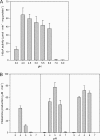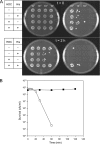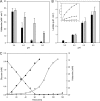Improved acid stress survival of Lactococcus lactis expressing the histidine decarboxylation pathway of Streptococcus thermophilus CHCC1524
- PMID: 22351775
- PMCID: PMC3322857
- DOI: 10.1074/jbc.M111.330704
Improved acid stress survival of Lactococcus lactis expressing the histidine decarboxylation pathway of Streptococcus thermophilus CHCC1524
Abstract
Degradative amino acid decarboxylation pathways in bacteria generate secondary metabolic energy and provide resistance against acid stress. The histidine decarboxylation pathway of Streptococcus thermophilus CHCC1524 was functionally expressed in the heterologous host Lactococcus lactis NZ9000, and the benefits of the newly acquired pathway for the host were analyzed. During growth in M17 medium in the pH range of 5-6.5, a small positive effect was observed on the biomass yield in batch culture, whereas no growth rate enhancement was evident. In contrast, a strong benefit for the engineered L. lactis strain was observed in acid stress survival. In the presence of histidine, the pathway enabled cells to survive at pH values as low as 3 for at least 2 h, conditions under which the host cells were rapidly dying. The flux through the histidine decarboxylation pathway in cells grown at physiological pH was under strict control of the electrochemical proton gradient (pmf) across the membrane. Ionophores that dissipated the membrane potential (ΔΨ) and/or the pH gradient (ΔpH) strongly increased the flux, whereas the presence of glucose almost completely inhibited the flux. Control of the pmf over the flux was exerted by both ΔΨ and ΔpH and was distributed over the transporter HdcP and the decarboxylase HdcA. The control allowed for a synergistic effect between the histidine decarboxylation and glycolytic pathways in acid stress survival. In a narrow pH range around 2.5 the synergism resulted in a 10-fold higher survival rate.
Figures








Similar articles
-
HdcB, a novel enzyme catalysing maturation of pyruvoyl-dependent histidine decarboxylase.Mol Microbiol. 2011 Feb;79(4):861-71. doi: 10.1111/j.1365-2958.2010.07492.x. Epub 2011 Jan 5. Mol Microbiol. 2011. PMID: 21208300
-
Effect of chemico-physical parameters on the histidine decarboxylase (HdcA) enzymatic activity in Streptococcus thermophilus PRI60.J Food Sci. 2012 Apr;77(4):M231-7. doi: 10.1111/j.1750-3841.2012.02628.x. Epub 2012 Mar 19. J Food Sci. 2012. PMID: 22429258
-
Sequencing and transcriptional analysis of the Streptococcus thermophilus histamine biosynthesis gene cluster: factors that affect differential hdcA expression.Appl Environ Microbiol. 2010 Sep;76(18):6231-8. doi: 10.1128/AEM.00827-10. Epub 2010 Jul 23. Appl Environ Microbiol. 2010. PMID: 20656875 Free PMC article.
-
Experimental determination of control of glycolysis in Lactococcus lactis.Antonie Van Leeuwenhoek. 2002 Aug;82(1-4):237-48. Antonie Van Leeuwenhoek. 2002. PMID: 12369190 Review.
-
Lactococcus lactis and stress.Antonie Van Leeuwenhoek. 1996 Oct;70(2-4):243-51. doi: 10.1007/BF00395935. Antonie Van Leeuwenhoek. 1996. PMID: 8879409 Review.
Cited by
-
In situ monitoring of Lentilactobacillus parabuchneri biofilm formation via real-time infrared spectroscopy.NPJ Biofilms Microbiomes. 2022 Nov 19;8(1):92. doi: 10.1038/s41522-022-00353-5. NPJ Biofilms Microbiomes. 2022. PMID: 36402858 Free PMC article.
-
Improvement of macrolactins production by the genetic adaptation of Bacillus siamensis A72 to saline stress via adaptive laboratory evolution.Microb Cell Fact. 2022 Jul 19;21(1):147. doi: 10.1186/s12934-022-01871-9. Microb Cell Fact. 2022. PMID: 35854349 Free PMC article.
-
Partial rpoB Gene Sequencing Identification and Probiotic Potential of Floricoccus penangensis ML061-4 Isolated from Assam Tea (Camellia sinensis var. assamica).Sci Rep. 2019 Nov 12;9(1):16561. doi: 10.1038/s41598-019-52979-9. Sci Rep. 2019. PMID: 31719601 Free PMC article.
-
ClC transporter activity modulates histidine catabolism in Lactobacillus reuteri by altering intracellular pH and membrane potential.Microb Cell Fact. 2019 Dec 12;18(1):212. doi: 10.1186/s12934-019-1264-0. Microb Cell Fact. 2019. PMID: 31830990 Free PMC article.
-
Technological Factors Affecting Biogenic Amine Content in Foods: A Review.Front Microbiol. 2016 Aug 12;7:1218. doi: 10.3389/fmicb.2016.01218. eCollection 2016. Front Microbiol. 2016. PMID: 27570519 Free PMC article. Review.
References
-
- Abe K., Hayashi H., Maloney P. C. (1996) Exchange of aspartate and alanine. Mechanism for development of a proton-motive force in bacteria. J. Biol. Chem. 271, 3079–3084 - PubMed
-
- Pereira C. I., San Romão M. V., Lolkema J. S., Crespo M. T. (2009) Weissella halotolerans W22 combines arginine deiminase and ornithine decarboxylation pathways and converts arginine to putrescine. J. Appl. Microbiol. 107, 1894–1902 - PubMed
-
- Soksawatmaekhin W., Kuraishi A., Sakata K., Kashiwagi K., Igarashi K. (2004) Excretion and uptake of cadaverine by CadB and its physiological functions in Escherichia coli. Mol. Microbiol. 51, 1401–1412 - PubMed
Publication types
MeSH terms
Substances
LinkOut - more resources
Full Text Sources

